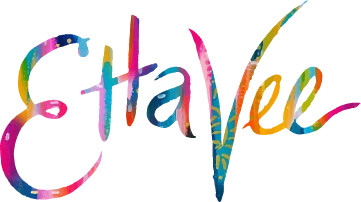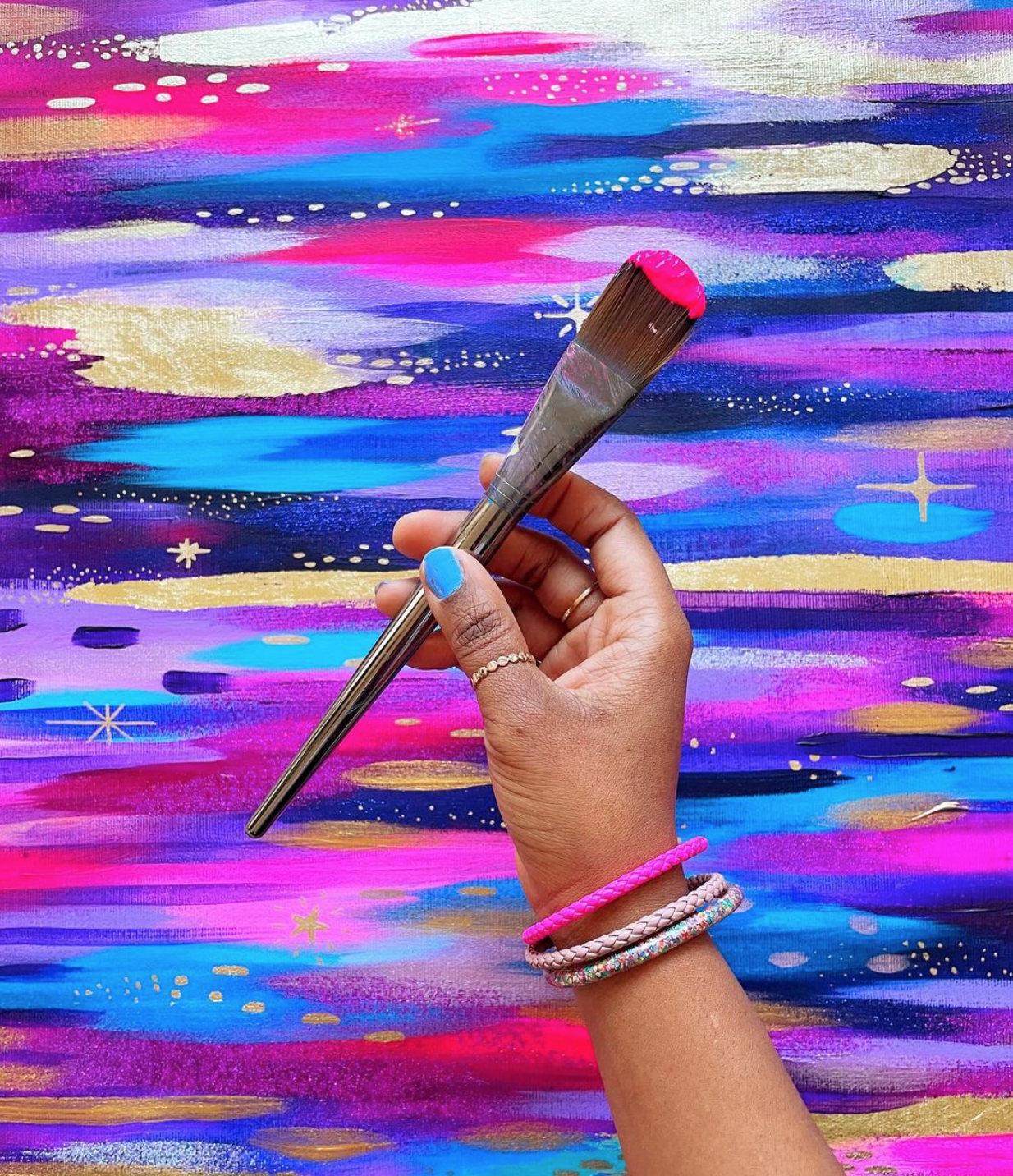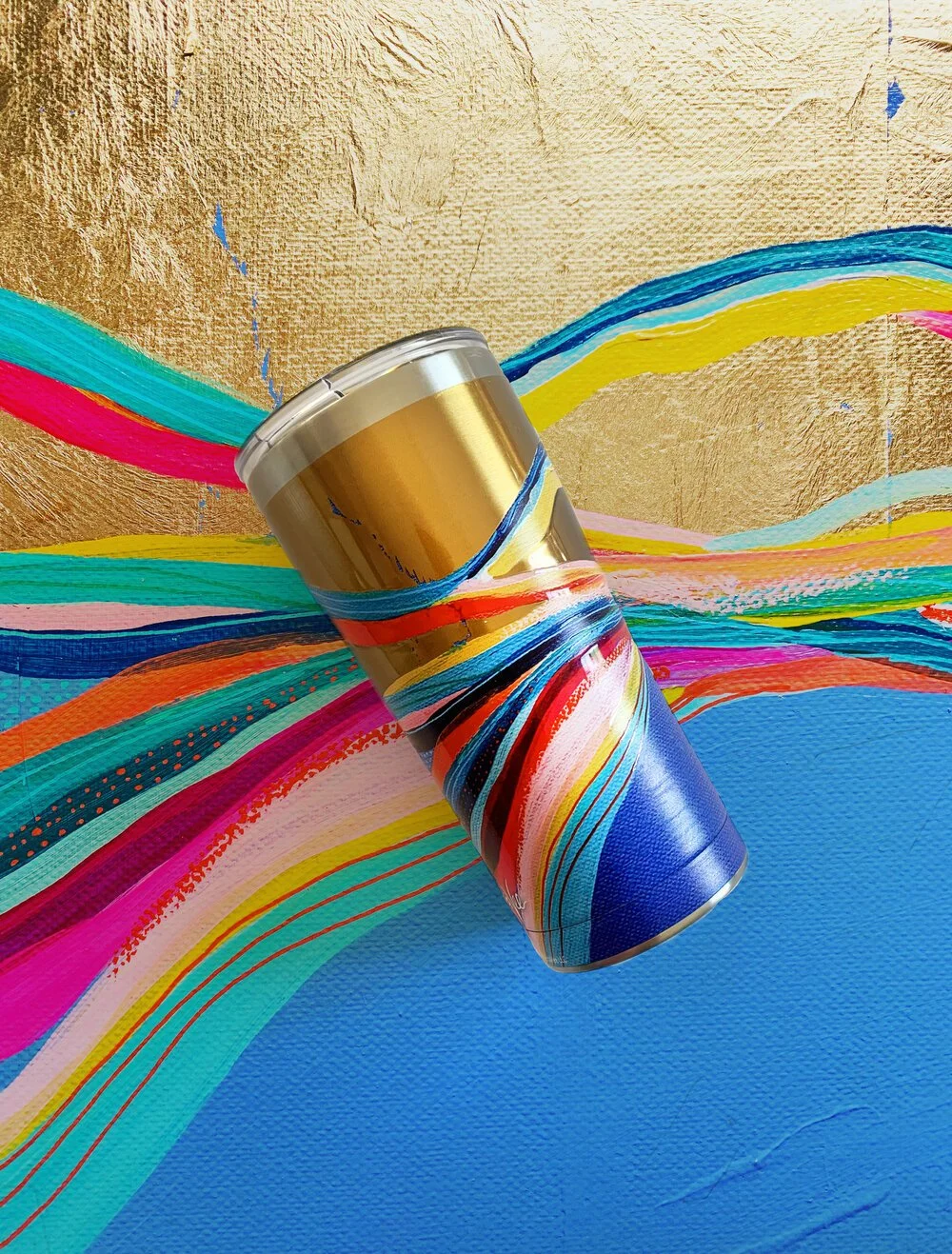How to Paint Intuitively: A Beginner’s Guide to Expressive Art
When you go into art or design school, you learn that a big part of creating art is planning. Sketching, ideating, gathering references, creating color studies, and mapping out each brushstroke. That kind of thoughtful process definitely has its place. But over time, I’ve found that some of my very favorite pieces are the ones that didn’t follow a plan at all. They just… flowed.
There’s something magical about putting brush to canvas and letting your feelings lead the way.
That’s what intuitive painting is all about: tapping into joy, emotion, and freedom without worrying about the rules. This type of painting can also be an incredible form of self-care. And I think we could all use a little extra self care these days.
So let’s dive into how to get started with intuitive painting!
What is Intuitive Painting?
Intuitive painting is all about letting go of expectations and tuning into your feelings. Instead of painting something realistic or following a step-by-step plan, you allow your mood, movement, and creativity to take the lead.
You can think of it like a visual journal. It’s expressive, freeing, and playful. Bold brushstrokes? Go for it. Surprising color combinations? Absolutely. This is your safe space to experiment.
And the best part is, there’s no right or wrong. Just you exploring what lights you up.
The Intuitive Painting Mindset Shift
The hardest part of intuitive painting isn’t picking your colors or choosing a brush, it’s quieting that inner voice that says “this has to look good or it doesn’t count.”
To paint intuitively, you have to give yourself permission to explore. To be brave. To play. Let go of the pressure to make something pretty and instead focus on making something that truly lights you up.
Come into the process knowing that you’ll make a few “mistakes” and you’ll have some things you want to paint over. But the key is to remember that you’re here to enjoy the process, not make something perfect.
For My Type-A Girlies…
Now, if you're like me and appreciate a little creative structure, here's a little tip: having a ~loose~ plan can make intuitive painting feel a little less scary.
This doesn’t mean you have to map out your whole composition, but it does mean that you can give yourself a jumping-off point. Here are a couple suggestions to get you started:
Pick a favorite color or palette. (Need ideas? My Hot Pink Color Palette post is full of juicy combos.)
Use a photo that inspires you. This could be from a trip, your garden, or anything you snapped a picture of that inspires you. And if you want, I have more tips for finding great inspo right here.
A tiny bit of intention can give you the confidence to dive in without freezing up at that blank canvas.
Create Your Simple Intuitive Painting Ritual
Here’s a little flow I use when I want to paint intuitively. Feel free to follow it step by step, or just use it as inspiration to create your own vibe:
Set the mood. Light a candle. Put on music that vibes with the emotion you want to convey in your piece. Create an atmosphere that feels calm and cozy or energetic and electric. Whatever matches your mood!
Pick a color that reflects how you feel. This will become the anchor of your piece (mine is usually fluorescent pink 😅)
Make your first brushstrokes. Don’t overthink it, just begin. If you’re feeling energetic, go for big bold strokes. If you’re craving calm, use soft, flowing lines.
Look for unexpected magic that excites you. Maybe two colors blend in a surprising way. Maybe you get a great texture from a brush you forgot you had. Notice those moments that light you up, and create more of them as you keep painting.
Pause and step back. Every now and then it’s helpful to take a step back from your painting, breathe, and see how you’re feeling. Sometimes these pauses are when the best bolts of creative inspo hit us!
Inspiration to Get You Started
If you're feeling stuck on how to begin, here are a few fun prompts to play with:
Choose three colors and see where they take you.
Paint how a memory felt like your favorite vacation or that first cup of coffee on a slow morning.
Pick a brushstroke pattern and use it across the whole painting. Some examples from my own work included swishes, v-shaped brushstroke patterns, and wavy lines.
What to Do When You Don’t Like Your Painting
First of all, welcome to the club. Every artist has been there!
Painting is a process, and every piece goes through an ugly stage. Sometimes the only way out is through. So if you're not loving how it's looking, try pushing a little further. Let the painting surprise you. Make some bold choices! Sometimes a big, energetic brushstroke is all you need to bring a painting out of a funk.
And remember, acrylic is super forgiving. You can always paint over it!
Treat each painting like an experiment, not a final masterpiece. You’re learning with every brushstroke, even if the final piece doesn’t end up on your wall.
Keep Going! The More You Paint, the More You Know Yourself
The more you practice intuitive painting (even just once a week!), the more your confidence and style will evolve. You’ll start to notice what colors you gravitate toward, what brushstrokes feel good, and what textures feel like you!
That’s how you develop your voice as an artist. One brave painting session at a time.
Still Feeling a Bit Intimidated? Take a Class to Help it Flow!
If that blank canvas is still staring you down, I’ve got you.
Sometimes it helps to follow a guided class to get the creativity flowing. I recommend starting with my Spring Sky class. It’s one of my most popular step-by-step tutorials, and it’s a beautiful way to ease into intuitive painting with a little more structure.
You’ve got this. I can’t wait to see what you create.
And remember, if you need a little guidance, you can always check out my online classes for fun, vibrant, structured painting tutorials!
Happy painting!
xo, Jessi







